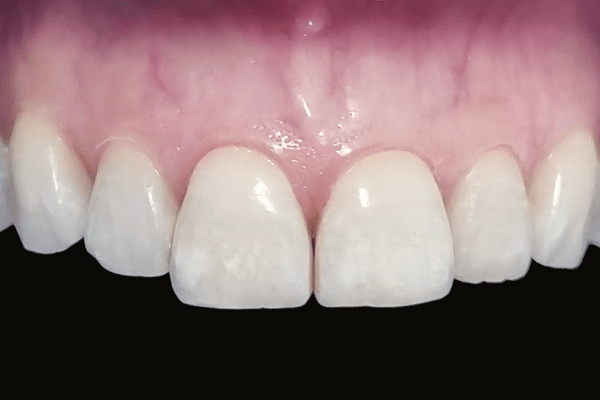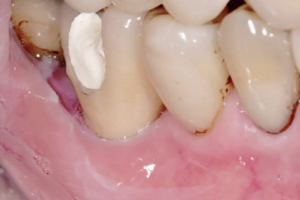RESUMO
Na última década, várias pesquisas sugeriram que o fenótipo gengival fino ou espesso responde de maneira diferente aos variados tratamentos odontológicos. Objetivo: discutir, com base em uma revisão narrativa da literatura, os diferentes métodos para classificação do fenótipo gengival e/ou periodontal, bem como a relevância clínica do diagnóstico. Material e métodos: através de uma pesquisa realizada no PubMed, foram selecionados artigos que comparavam pelo menos dois métodos para classificar o fenótipo gengival, com vantagens e desvantagens, facilidade na reprodutibilidade e confiabilidade dos mesmos. Resultados: os trabalhos científicos sugerem que dois métodos para classificação do fenótipo gengival são praticados pela maioria dos clínicos: o visual e o da transparência à sondagem. Embora recomendado, o método de classificação através da transparência à sondagem ainda é subjetivo, podendo gerar confusão nesse diagnóstico. Existe uma grande relevância clínica no diagnóstico correto do fenótipo gengival, pelo impacto que isso pode causar no resultado de um tratamento em Implantodontia. Conclusão: com base nessa revisão, embora os métodos clínicos de avaliação do fenótipo gengival sejam os mais utilizados na prática diária, as medições nas tomografias de feixe cônico com afastamento de lábio têm um papel fundamental para determinação do fenótipo periodontal, já que sua atual definição é baseada no fenótipo gengival (espessura gengival), faixa de gengiva queratinizada e espessura da tábua óssea vestibular (morfologia óssea).
Palavras-chave – Fenótipo gengival; Fenótipo periodontal; Biotipo gengival; Biotipo periodontal; Classificação do fenótipo gengival; Espessura gengival.
ABSTRACT
In the last decade, several studies have suggested that thin or thick gingival phenotypes respond differently to varied dental treatments. Objective: to discuss, based on a narrative literature review, the different methods for classifying the gingival and/or periodontal phenotype, as well as the clinical relevance of the diagnosis. Material and methods: a search in PubMed selected articles that compared at least two methods to classify the gingival phenotype, with advantages and disadvantages, ease of reproducibility and reliability. Results: scientific works suggests that two methods for classifying the gingival phenotype are practiced by most clinicians; visual and probe transparency. Although recommended, the transparency approach is still subjective and can generate confusion. There is great clinical relevance in correctly diagnosing the gingival phenotype due to the impact this can have on the result of an implant dentistry treatment. Conclusion: based on this review, although clinical methods for evaluating the gingival phenotype are the most used in daily practice, measurements on cone beam tomography with lip retaction have a crucial role in determining the periodontal phenotype, since its current definition It is based on gingival phenotype (gingival thickness), range of keratinized gingiva, and thickness of the buccal bone plate (bone morphology).
Key words – Gingival phenotype; Periodontal phenotype; Gingival biotype; Periodontal biotype; Phenotype classification; Gingival thickness.
Referências
- Fürhauser R, Florescu D, Benesch T, Haas R, Mailath G, Watzek G. Evaluation of soft tissue around single-tooth implant crowns: the pink esthetic score. Clin Oral Implants Res 2005;16(6):639-44.
- Elian N, Ehrlich B, Jalbout ZN, Classi AJ, Cho SC, Kamer AR et al. Advanced concepts in implant dentistry: creating the “aesthetic site foundation”. Dent Clin North Am 2007;51(2):547-63.
- Zweers J, Thomas RZ, Slot DE, Weisgold AS, Van der Weijden FG. Characteristics of periodontal biotype, its dimensions, associations and prevalence: a systematic review. J Clin Periodontol 2014;41(10):958-71.
- Malpartida-Carrillo V, Tinedo-Lopez PL, Guerrero ME, Amaya-Pajares SP, Özcan M, Rösing CK. Periodontal phenotype: a review of historical and current classifications evaluating different methods and characteristics. J Esthet Restor Dent 2021;33(3):432-45.
- Eghbali A, De Rouck T, De Bruyn H, Cosyn J. The gingival biotype assessed by experienced and inexperienced clinicians. J Clin Periodontol 2009;36(11):958-63.
- Kan JY, Morimoto T, Rungcharassaeng K, Roe P, Smith DH. Gingival biotype assessment in the esthetic zone: visual versus direct measurement. Int J Periodontics Restorative Dent 2010;30(3):237-43.
- Stellini E, Comuzzi L, Mazzocco F, Parente N, Gobbato L. Relationships between different tooth shapes and patient’s periodontal phenotype. J Periodontal Res 2013;48(5):657-62.
- Pini Prato G, Di Gianfilippo R, Pannuti CM, Allen EP, Aroca S, Avila-Ortiz G et al. Diagnostic reproducibility of the 2018 classification of gingival recession defects and gingival phenotype: a multicenter inter- and intra-examiner agreement study. J Periodontol 2023;94(5):661-72.
- Kim DM, Bassir SH, Nguyen TT. Effect of gingival phenotype on the maintenance of periodontal health: an American Academy of Periodontology best evidence review. J Periodontol 2020;91(3):311-38.
- Nisanci Yilmaz MN, Koseoglu Secgin C, Ozemre MO, İnonu E, Aslan S, Bulut S. Assessment of gingival thickness in the maxillary anterior region using different techniques. Clin Oral Investig 2022;26(11):6531-8.
- da Costa FA, Perussolo J, Dias DR, Araújo MG. Identification of thin and thick gingival phenotypes by two transparency methods: a diagnostic accuracy study. J Periodontol 2023;94(5):673-82.
- Soltani P, Yaghini J, Rafiei K, Mehdizadeh M, Armogida NG, Esposito L et al. Comparative evaluation of the accuracy of gingival thickness measurement by clinical evaluation and intraoral ultrasonography. J Clin Med 2023;12(13):4395.
- Pini Prato G, Di Gianfilippo R. On the value of the 2017 classification of phenotype and gingival recessions. J Periodontol 2021;92(5):613-8.
- Fischer KR, Büchel J, Testori T, Rasperini G, Attin T, Schmidlin P. Gingival phenotype assessment methods and classifications revisited: a preclinical study. Clin Oral Investig 2021;25(9):5513-8. Erratum in: Clin Oral Investig 2021.
- Yilmaz MNN, Inonu E. The evaluation of gingival phenotype by clinicians using the visual inspection method. Quintessence Int 2023;54(7):600-6.
- Januário AL, Barriviera M, Duarte WR. Soft tissue cone-beam computed tomography: a novel method for the measurement of gingival tissue and the dimensions of the dentogingival unit. J Esthet Restor Dent 2008;20(6):366-73.
- Rodrigues DM, Chambrone L, Montez C, Luz DP, Barboza EP. Current landmarks for gingival thickness evaluation in maxillary anterior teeth: a systematic review. Clin Oral Investig 2023;27(4):1363-89.
- Rodrigues DM, Petersen RL, de Moraes JR, Barboza EP. Gingival landmarks and cutting points for gingival phenotype determination: a clinical and tomographic cross-sectional study. J Periodontol 2022;93(12):1916-28.
- Shafizadeh M, Amid R, Tehranchi A, Motamedian SR. Evaluation of the association between gingival phenotype and alveolar bone thickness: a systematic review and meta-analysis. Arch Oral Biol 2022;133:105-287.
- Cosyn J, Eghbali A, Hermans A, Vervaeke S, De Bruyn H, Cleymaet R. A 5-year prospective study on single immediate implants in the aesthetic zone. J Clin Periodontol 2016;43(8):702-9.
- Canullo L, Camacho-Alonso F, Tallarico M, Meloni SM, Xhanari E, Penarrocha-Oltra D. Mucosa thickness and peri-implant crestal bone stability: a clinical and histologic prospective cohort trial. Int J Oral Maxillofac Implants 2017;32(5):675-81.
- Giannobile WV, Jung RE, Schwarz F, Groups of the 2nd Osteology Foundation Consensus Meeting. Evidence-based knowledge on the aesthetics and maintenance of peri-implant soft tissues: Osteology Foundation Consensus Report Part 1 – effects of soft tissue augmentation procedures on the maintenance of peri-implant soft tissue health. Clin Oral Implants Res 2018;29(suppl.15):7-10.
- Al-Sabbagh M, Xenoudi P, Al-Shaikhli F, Eldomiaty W, Hanafy A. Does peri-implant mucosa have a prognostic value? Dent Clin North Am 2019;63(3):567-80.
- Kong J, Aps J, Naoum S, Lee R, Miranda LA, Murray K et al. An evaluation of gingival phenotype and thickness as determined by indirect and direct methods. Angle Orthod 2023;93(6):675-82.





